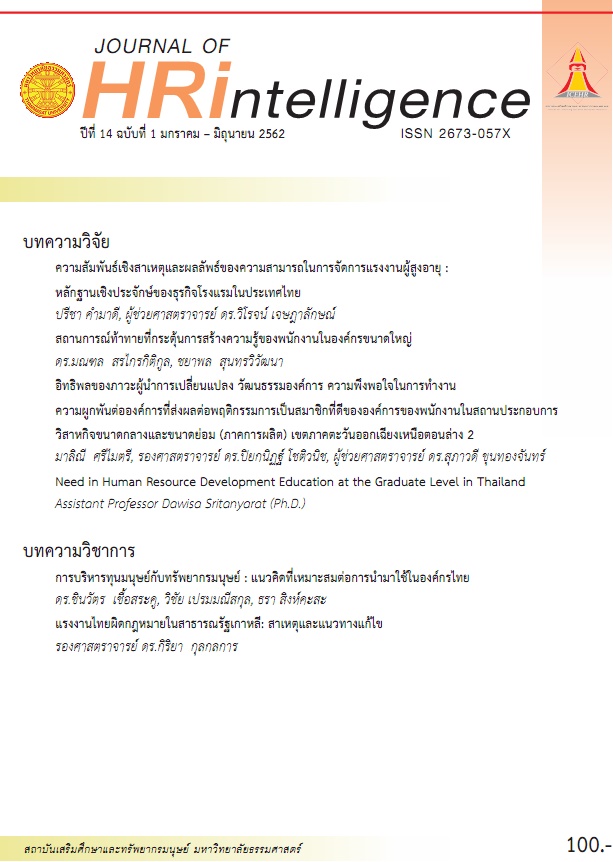Needs in Human Resource Development Education at the Graduate Level in Thailand
Main Article Content
Abstract
The educational programs in Human Resource Development (HRD) in Thailand have operated for more than 20 years, with a partnership between scholars and practitioners (McLean & Akaraborworn, 2014). As the quality of educational programs requires the content to be up-to-date and suitable for current situations (Kuchinke, 2007; Sritanyarat & Russ-Eft, 2016), this paper provides an understanding of the needs in HRD Education at the graduate level in Thailand. A review of literature and interviews with HRD education stakeholders were performed to develop the questionnaire. Further, a survey was performed with various stakeholders. It was found that the most needed areas in HRD education were communication, talent management, consultation, and organizational culture. Exploratory factor analysis categorized the subject areas into ten groups, including human resource development in different contexts, such as individual level organizational level, and international context, human resource management, research methods, business management, theory-based courses, and ethics. The results of this study aligned with the literature, as well as Thailand’s HR professional standards. This paper reveals the expected outcomes of HRD programs and offers implications for designing, improving, and evaluating curriculum of the HRD programs according to the needs of various stakeholders.
Article Details
ขอมอบลิขสิทธิ์บทความที่ได้รับการตีพิมพ์ให้แก่สถาบันเสริมศึกษาและทรัพยากรมนุษย์ กรณีมีการฟ้องร้องเรื่องการละเมิดลิขสิทธิ์เกี่ยวกับภาพ กราฟ ข้อความส่วนใดส่วนหนึ่ง และ/หรือข้อคิดเห็นที่ปรากฎในบทความ ให้เป็นความรับผิดชอบของข้าพเจ้าและผู้เขียนร่วมแต่เพียงผู้เดียว
References
Akaraborworn, C. T. (2014). Global HR trends 2014-2015. Retrieved from https://www.manpowerthailand.com/uploads/news/filepd_1ebf629c6e4e261c5345c8114cadb515.pdf
Cooper, D. R., & Schindler, P. S. (2006). Business Research Methods. New York, NY: McGraw Hill.
Creswell, J. W., & Creswell, J. D. (2005). Mixed method research: Developments, debates, and dilemmas. In R. A. Swanson & E. F. Holton III (Eds.), Research in organizations: Foundations and methods of inquiry (pp. 315-326). San Francisco, CA: Berrett-
Koehler.
Garavan, T. M. (1997). Training, development, education and learning: Different or the same? Journal of European Industrial Training, 21(2), 39-50.
Glesne, C. (2011). Becoming Qualitative Researchers (4th ed.). Boston, MA: Pearson.
Green, D. (1994). What is quality in higher education Concept, practice and policies. In Green, D. (Ed.), What is quality in higher education? (pp. 3-19). PA: Taylor and Francis.
Greene, J. C., Caracelli, V. J., & Graham, W. F. (1989). Toward a conceptual framework for mixed-method evaluation designs. Educational Evaluation and Policy Analysis, 11(3), 255–274. doi:10.3102/01623737011003255
Hair, J. F., Anderson, R. E., Tatham, R. L., & Black, W. C. (1998). Multivariate Data Analysis (5th ed.). Upper Saddle River, NJ: Prentice Hall.
Hite, L. M., & McDonald, K. S. (2010). Perspectives on HRD and diversity education. Advances in Developing Human Resources, 12(3), 283-294. doi: 10.1177/1523422310374974
Kormanik, M. B., & Rajan, H. C. (2010). Implications for diversity in the HRD curriculum drawn from current organizational practices on addressing workforce diversity in management training. Advances in Developing Human Resources, 12(3), 367-384. doi:
10.1177/1523422310375033
Krejcie, R. V., & Morgan, D. W. (1970). Determining sample size for research activities. Educational and Psychological Measurement, 30, 607-610.
Kuchinke, P. K. (2001). HRD university education: an international research agenda. Human Resource Development International, 4(2), 253-261. doi: 10.1080/13678860010006121
Kuchinke, P. K. (2002). Institutional and curricular characteristics of leading graduate HRD programs in the United States. Human Resource Development Quarterly, 13(2), 127-144. doi: 10.1002/hrdq.1019
McDonald, K. S., & Hite, L. M. (2010). Diversity in the HRD curriculum: Concluding thoughts and next steps. Advances in Developing Human Resources, 12(3), 385-391. doi: 10.1177/1523422310375032
McGuire, D. (2010). Foundations of human resource development. Retrieved from https://www.sagepub.com/upm-data/36589_01_McGuire_CH_01.pdf.
McLean, G. N., & Akaraborworn, C. (2014). HRD education in developing countries. In D. Cho, K. Ryu, and M. Akdere (Eds.), Proceedings of the 13th International Conference of the Asia Chapter of Academy of Human Resource Development.Seoul, Korea: Academy of Human Resource Development.
McLean, G. N., & McLean, L. D. (2001). If we can't define HRD in one country, how can we define it in an international context? Human Resource Development International, 4(3), 313-326.
Na Chiangmai, C. (October, 1998). Current outlook and trends of HRD in Thailand. Paper Presented at the International HRD. University of Minnesota, St. Paul, MN.
Nadler, C., & Nadler, Z. (1992), Every Manager’s Guide to Human Resource Development. San Francisco, CA: Jossey-Bass,
Office of the National Economic and Social Development Board. (2008). The 8th National Economic and Social Development Plan. Retrieved from https://www.nesdb.go.th/Default.aspx?tabid=90.
School of Human Resource Development National Institute of Development Administration. (2013). Master of Science Program in Human Resource and Organization Development (Version B.E. 2556). Retrieved from
https://www.hrd.nida.ac.th/hrodnida/rtefile/rte_690.pdf.
Society for Human Resource Management. (2015). Evolution of work and the worker: Five key trends from SHRM’s special expertise panels. Retrieved from https://www.shrm.org/about/foundation/products/Documents/2015%20Evol%20of%20Work-
Panel%20Report-FINAL.pdf.
Sritanyarat, D., & Russ-Eft, D. (2016). Empirical evaluation indicators in Thai higher education: Theory-based multidimensional learners’ assessment, International Journal of Instruction, 9(2), 3-18. doi: 10.12973/iji.2016.921a
Swanson, R. A. (1995). Performance is the key. Human Resource Development Quarterly, 6(2), 207-213.
Tam, M. (2001). Measuring quality and performance in higher education. Quality in Higher Education, 7(1), 47-54, doi: 10.1080/13538320120045076.
Thailand Human Resources Certification Institute. (2016). HR Occupational Standard Model. Retrieved from https://www.pmat.or.th/hrci/index.php


